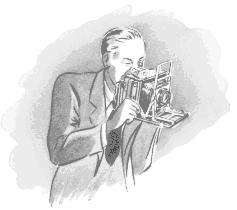| View previous topic :: View next topic |
| Author |
Message |
FixerFiend
Joined: 05 Sep 2003
Posts: 42
Location: Washington D.C.
|
 Posted: Sat Apr 17, 2004 10:30 am Post subject: Posted: Sat Apr 17, 2004 10:30 am Post subject: |
 |
|
While talking with a photog that Should know, he suggested that when useing older single coated(127 Ektar)lenses the flare and scatter would be such that I should increase development due to low contrast of these lenses.I've only printed 1 neg from this lense so far and it did seem a little flat.Does anyone have any comments on this, they would be much appreciated. Thanks.
_________________
BTM |
|
| Back to top |
|
 |
Nick
Joined: 16 Oct 2002
Posts: 494
|
 Posted: Sat Apr 17, 2004 12:12 pm Post subject: Posted: Sat Apr 17, 2004 12:12 pm Post subject: |
 |
|
If you find the negatives flat you should increase development. Assuming you've got the EI nailed down to begin with.
OTOH I don't think there really is much to the coated,multicoated or non-coated thing. The older lenses with no coating had to use simple designs with limited number of elements. You need to use a shade and not point it at the sun but the lenses worked fine. Coatings allowed lens designers more freedom.
Supposedly using lenses with a lot of coverage can cause bellows flare from all the light bouncing around in there. |
|
| Back to top |
|
 |
t.r.sanford
Joined: 10 Nov 2003
Posts: 812
Location: East Coast (Long Island)
|
 Posted: Sat Apr 17, 2004 12:17 pm Post subject: Posted: Sat Apr 17, 2004 12:17 pm Post subject: |
 |
|
It's probably a good idea to conduct some development tests to find the time that gets the best results for you, whatever lens you're using.
I don't think one can generalize about single-coated, or uncoated, lenses. Much depends on the illumination and the subject. If the light is behind you and the subject has no very bright large areas, you may not be able to tell whether the lens is coated or not. |
|
| Back to top |
|
 |
Les
Joined: 09 May 2001
Posts: 2682
Location: Detroit, MI
|
 Posted: Sat Apr 17, 2004 2:03 pm Post subject: Posted: Sat Apr 17, 2004 2:03 pm Post subject: |
 |
|
I think you'll find this axiom to vary with the lens design. The planar and to a lesser extent the dialyte (Artar) were both designed in the late 19th early 20th century.
The Planar was a disappointment except for use on copy cameras where the light was controled. Outside, the lens exhibited too much internal flare due to the 8 air to glass surfaces. It wasn't until hard coatings came around that both of these lenses came into their own.
At the other end of the spectrum. The Dagor is helped very little with coating because it has only 4 air to glass surfaces.
A few years ago I think View Camera magazine did some exhaustive tests between a "merely" single coated 10" wide field Ektar and a super multi coated modern lens.
Their results were that both could resolve more than you'll ever need, the Ektar was a bit less contrasty, but that allowed for a bit more detail, and to match the modern lens they suggesting printing on the next grade higher paper.
Les
|
|
| Back to top |
|
 |
t.r.sanford
Joined: 10 Nov 2003
Posts: 812
Location: East Coast (Long Island)
|
 Posted: Sat Apr 17, 2004 2:37 pm Post subject: Posted: Sat Apr 17, 2004 2:37 pm Post subject: |
 |
|
Certainly, the amount of flare you have to contend with depends a lot on the lens design, when the lens is uncoated.
I'm less sure of the importance of multi-coating versus single coating; I'm sure it does some good, but I don't think its absence is a real deficiency.
"Tessar" formula lenses, like the f:4.7 "Ektar," represented a good compromise between the number of different curves available to the designer to correct aberrations, and the number of air/glass surfaces that can cause flare. "Tessar" type lenses were popular long before modern lens coating techniques were introduced.
I quite agree that, once you've got a developing time that gives you good results, the paper contrast grade you choose ought to deal with most situations you'll encounter in the real world. |
|
| Back to top |
|
 |
glennfromwy
Joined: 29 Nov 2001
Posts: 903
Location: S.W. Wyoming
|
 Posted: Sat Apr 17, 2004 3:57 pm Post subject: Posted: Sat Apr 17, 2004 3:57 pm Post subject: |
 |
|
The only function of the coating is to reduce internal reflections in the lens, thus allowing more of the light (image) to reach the film. Of course, this will give more contrast. Some, if not all of the uncoated Ektars actually had a single coating only on interior surfaces (Kodak data - 1940). Some of the most popular lens designs were uncoated and are still highly regarded. One needs to nail down exposure and development to get full benefit from these lenses. That can only be done by personal testing.
_________________
Glenn
"Wyoming - Where everybody is somebody else's weirdo" |
|
| Back to top |
|
 |
|


